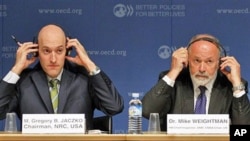U.S. nuclear officials say exhaustive reviews of safety standards and procedures have been conducted at American reactors since the Japanese nuclear crisis stemming from a March earthquake and tsunami. That's what leaders of the Nuclear Regulatory Commission sought to reassure wary lawmakers Thursday at a senate hearing.
One hundred and four nuclear power reactors currently operate in the United States, providing roughly 20 percent of the nation’s electricity. It has been more than three decades since the United States suffered a major nuclear scare - the 1979 partial core meltdown at Three Mile Island in Pennsylvania, which resulted in no deaths or injuries.
But recent events in Japan have refocused attention on nuclear safety and accident preparedness in the United States. Democratic Senator Frank Lautenberg of New Jersey summed up the concerns of many lawmakers:
“Since Japan’s nuclear disaster began unfolding, Americans have asked, with a good deal of trepidation: could it happen here? Nothing can be taken for granted where nuclear power is concerned," said Lautenberg. "Japan, a world leader in technology, believed the Fukushima plant was strong enough to withstand a worst-case scenario. And now we know it was not.”
All five commissioners of the Nuclear Regulatory Commission were on hand to answer senators’ questions. Chairman Gregory Jaczko detailed the commission’s actions since the Japanese crisis began.
“We issued instructions to our inspectors calling for immediate, independent assessments of each plant’s level of preparedness. The instructions covered extensive damage mitigation guidelines, station blackout, flooding, and seismic issues, as well as severe accident management guidelines,” he said.
Last month, the NRC reported that potential safety issues had been detected at 12 nuclear facilities.
The chairwoman of the Senate Committee on the Environment, Barbara Boxer, seemed troubled by problems discovered at a nuclear site in her home state of California.
“NRC’s inspections at the Diablo Canyon power plant [in California] found that state highways and access roads needed to reach diesel fuel and an alternative seawater source for cooling may be inaccessible after an earthquake," said Boxer. "And hoses needed to get cooling water from the reservoir to the plant were blocked by a security fence.”
The NRC said such issues are being corrected.
The commissioners acknowledged there are lessons to be learned from the Japanese nuclear crisis. Jaczko highlighted one lesson in particular.
“Our traditional approach has always been to assume a single incident at a single reactor," he said. "Clearly Fukushima-Daiichi showed us that we have to consider the possibility of multiple units at a single site, perhaps multiple spent fuel pools being affected at the same time.”
The hearing exposed divided opinions in the Senate on the wisdom and utility of employing nuclear power in the United States. Republican Senator Lamar Alexander of Tennessee is a strong supporter.
“The subject in America today is jobs. We want jobs (and) we have got to have large amounts of reliable, low-cost electricity," said Alexander. "Seventy percent of our carbon-free, sulfur-free, nitrogen-free, mercury-free electricity comes from nuclear plants.”
Democratic Senator Jeff Merkeley of Oregon is far less enthusiastic.
“I have a lot of doubts about nuclear power being able to be competitive, taking into account costs, potential terror threats, natural disasters, and human error," he said. "But I also think it is very important to look at all options as we wrestle with ways to generate non-carbon power.”
A political battle has raged for years over what to do with America’s spent nuclear fuel. A site in sparsely-populated Nevada was designated as a nuclear repository in the 1980s. Billions of dollars have been spent to develop the Yucca Mountain repository, but under President Barack Obama the project has been mothballed, with no replacement site identified to date.
US Nuclear Safety in Spotlight After Japanese Crisis












